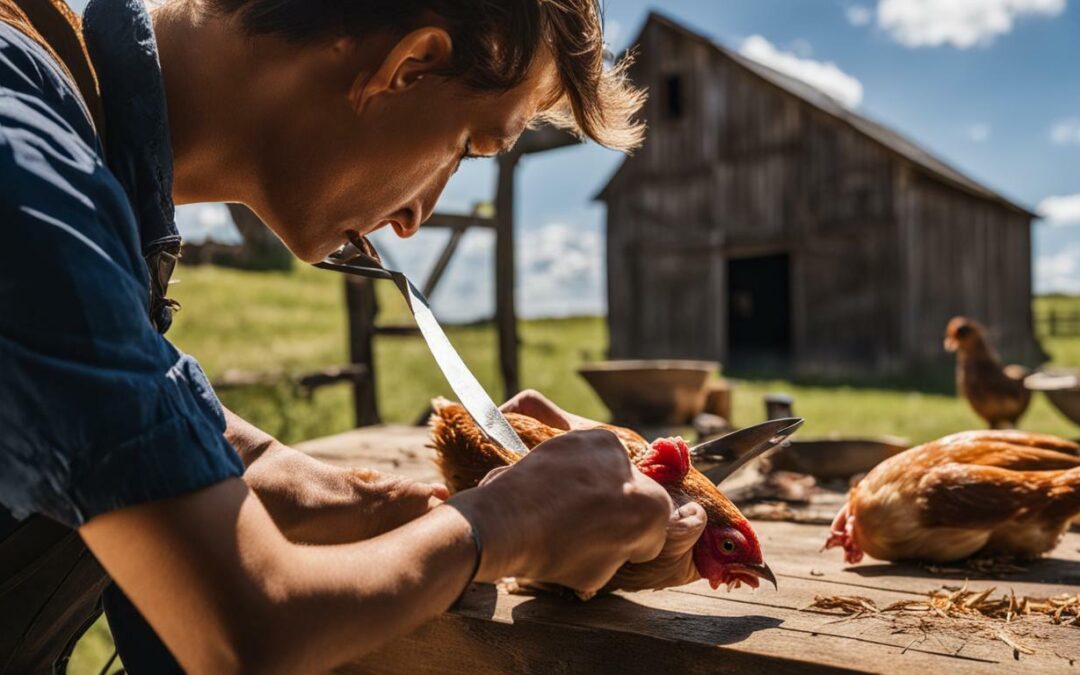Learning how to trim a chicken’s beak is an essential skill for poultry owners to ensure the health and well-being of their flock. Proper beak trimming helps chickens eat comfortably and establish their pecking order. This step-by-step guide will provide you with the necessary information to safely and effectively trim your chicken’s beak.
Key Takeaways:
- Trimming a chicken’s beak is important for their eating habits and social dynamics.
- You will need nail clippers, a nail file, a towel, a moist cloth or paper towel, styptic powder or cornstarch, sterile gauze, and electrolytes.
- Observe the coloration of the top beak to determine how much to trim.
- Use a nail file for slightly overgrown beaks, and clippers for moderately or greatly overgrown beaks.
- Always smooth any rough spots and wipe the beak clean.
Now let’s dive into the step-by-step process of trimming a chicken’s beak to ensure their comfort and well-being.
Why Trim a Chicken’s Beak?
Trimming a chicken’s beak not only helps them eat properly but also plays a crucial role in establishing the pecking order within the flock. By understanding the importance of beak trimming, poultry owners can ensure the well-being and social dynamics of their chickens.
When a chicken’s beak becomes overgrown, it can hinder their ability to eat and drink effectively. This can lead to malnutrition and dehydration, causing significant health issues. Trimming the beak allows chickens to access food and water without any hindrance, thus promoting their overall nutrition and well-being.
In addition to ensuring proper feeding, beak trimming helps establish the pecking order within the flock. Chickens use their beaks to establish dominance and maintain social hierarchy. Trimming their beaks prevents any one chicken from becoming too aggressive or overpowering others, resulting in a harmonious and balanced flock.
Tools Needed for Beak Trimming
Before you start trimming a chicken’s beak, gather the necessary tools, including nail clippers, a nail file, a towel, a moist cloth or paper towel, styptic powder or cornstarch, sterile gauze, and electrolytes. These tools will ensure a safe and effective beak trimming process.
Once you have all the tools ready, it’s important to secure the chicken in a towel to keep it still. This will prevent any unnecessary movements that may cause harm to the chicken or make the trimming process more difficult.
Step-by-Step Guide to Beak Trimming
- Observe the Beak: Open the chicken’s mouth and observe the coloration of the top beak to determine how much trimming is needed. If the beak is only slightly overgrown, a nail file can be used to sand it down evenly on both sides. Avoid filing back and forth, as this can cause uneven edges.
- Use Nail Clippers: If the beak is moderately or greatly overgrown, it’s best to use nail clippers. Trim a little at a time, alternating sides to maintain balance. Smooth out any rough spots with the nail file.
- Remove Dust and Fragments: After trimming, wipe the beak with a moist cloth or paper towel to remove any dust or fragments. This will ensure a clean and comfortable beak for the chicken.
- Address Bleeding: In some cases, bleeding may occur during the trimming process. If this happens, dip the beak in styptic powder or cornstarch to stop the bleeding. Wait until it stops completely before wiping off the excess powder or cornstarch.
- Provide Electrolytes: To combat any physical symptoms from stress, add electrolytes to the chicken’s waterer. This will help the chicken recover and maintain its overall health after the beak trimming procedure.
If bleeding is excessive or if the beak is cut into the living tissue, it is important to seek professional assistance. Trimming a chicken’s beak is an essential practice that helps them eat properly and establish their pecking order within the flock.
By following this step-by-step guide and using the proper tools, you can safely trim a chicken’s beak, ensuring their well-being and promoting their overall health.
Step-by-Step Beak Trimming Process
Begin the beak trimming process by securely wrapping the chicken in a towel to keep it calm and still. This will help minimize any potential stress or movement during the procedure.
Next, open the chicken’s mouth and observe the coloration of the top beak. This will give you an idea of how much trimming is necessary. If the beak is only slightly overgrown, you can use a nail file to sand it down evenly on both sides. Be sure to avoid filing back and forth, as this can create rough edges.
If the beak is moderately or greatly overgrown, it’s best to use nail clippers designed for small dogs or cats. Start by trimming a little at a time, alternating sides to maintain balance. After each trim, use the nail file to smooth any rough spots and ensure a clean cut.
After the trimming is complete, wipe the beak with a moist cloth or paper towel to remove any dust or fragments. If bleeding occurs during the process, dip the beak in styptic powder or cornstarch to promote clotting. Wait until the bleeding stops before wiping off the excess powder or cornstarch.
Finally, to help the chicken recover from any potential stress, consider adding electrolytes to their waterer. This can help combat physical symptoms and aid in their overall well-being. However, if there is excessive bleeding or if the beak is cut into the living tissue, it is crucial to seek professional assistance for proper care and treatment.
Remember, trimming a chicken’s beak is essential for their ability to eat and establish their pecking order. By following these steps and prioritizing the chicken’s safety and comfort, you can effectively maintain their beak health and ensure their overall well-being.
Dealing with Potential Issues
While trimming a chicken’s beak is usually straightforward, it’s important to be prepared for potential complications such as bleeding or cutting into the living tissue.
Here are some best practices to follow and steps to take if you encounter any issues during the beak trimming process:
- Excessive Bleeding: If you notice excessive bleeding after trimming the beak, don’t panic. Dip the chicken’s beak into styptic powder or cornstarch to help stop the bleeding. This will act as a natural coagulant. Wait until the bleeding stops before wiping off any excess powder.
- Cutting into the Living Tissue: In the unfortunate event that you accidentally cut into the living tissue of the beak, it’s crucial to seek professional assistance immediately. This can lead to significant bleeding and pain for the chicken, and it requires proper medical attention.
- Monitor for Infection: After trimming the beak, keep a close eye on the chicken for any signs of infection. Look out for swelling, redness, discharge, or any other abnormalities. If you notice any of these symptoms, consult a veterinarian for further guidance.
- Provide Comfort and Support: If your chicken is experiencing discomfort or stress after the beak trimming procedure, make sure to provide a calm and quiet environment for them to recover. Ensure they have access to fresh water and food, as well as electrolytes in their waterer to help combat any physical symptoms from stress.
Remember, trimming a chicken’s beak is done with their well-being in mind. If you encounter any difficulties or have concerns, it’s always better to seek professional assistance to ensure the chicken’s health and safety.
Conclusion
Trimming a chicken’s beak is a necessary part of poultry care, ensuring their ability to eat and maintain their social hierarchy within the flock. By following a few simple steps, you can safely trim your chicken’s beak and promote their overall well-being.
To trim a chicken’s beak, you will need a few essential tools: nail clippers made for a small dog or cat, a nail file, a towel, a moist cloth or paper towel, styptic powder or cornstarch, sterile gauze, and electrolytes. These items will help ensure a smooth and comfortable trimming process.
First, it’s important to secure the chicken in a towel to keep it still during the trimming process. Gently open the chicken’s mouth and observe the coloration of the top beak. This will help you determine how much to trim. If the beak is only slightly overgrown, you can use a nail file to sand it down evenly on both sides, avoiding filing back and forth.
If the beak is moderately or greatly overgrown, you can use the nail clippers to trim a little at a time, alternating sides and smoothing any rough spots with the file. After trimming, wipe the beak with a moist cloth or paper towel to remove any dust or fragments.
If bleeding occurs during the trimming process, don’t panic. Simply dip the beak in styptic powder or cornstarch and wait until the bleeding stops before wiping it off. It’s also essential to add electrolytes to the chicken’s waterer to combat any physical symptoms from stress.
However, it’s crucial to note that if there is excessive bleeding or if the beak is cut into the living tissue, it is best to seek professional assistance. Trimming a chicken’s beak should be done with caution and proper knowledge to avoid any harm.
Overall, trimming a chicken’s beak not only helps them eat properly but also allows them to establish their pecking order and maintain their social hierarchy within the flock. By following the steps outlined in this guide, you can ensure the health and well-being of your chickens.
FAQ
Can I use regular nail clippers to trim a chicken’s beak?
It is recommended to use nail clippers made for a small dog or cat, as they are designed to be safe and effective for trimming a chicken’s beak.
How do I determine how much to trim off the chicken’s beak?
By observing the coloration of the top beak, you can determine how much to trim. If it is slightly overgrown, use a nail file to sand it down evenly on both sides. If it is moderately or greatly overgrown, use clippers to trim a little at a time.
What should I do if the chicken’s beak starts bleeding?
If bleeding occurs, dip the beak in styptic powder or cornstarch and wait until it stops before wiping it off. This will help stop the bleeding.
Do I need any additional supplies for beak trimming?
It is advisable to have a towel to secure the chicken, a moist cloth or paper towel to clean the beak, sterile gauze for any potential injuries, and electrolytes to add to the chicken’s waterer to combat physical symptoms from stress.
Is it normal for the beak to have rough spots after trimming?
Yes, it is possible for rough spots to occur after trimming. In such cases, use a nail file to smooth out any rough spots and ensure a clean and even beak surface.
What should I do if I accidentally cut into the living tissue of the beak?
If there is excessive bleeding or if the beak is cut into the living tissue, it is recommended to seek professional assistance to ensure proper treatment and care for the chicken.

